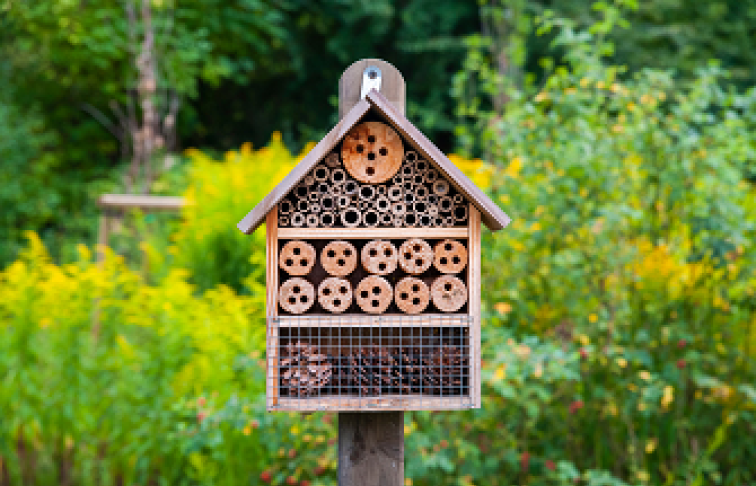Manage your account and see your money through our mobile banking app or on your computer through our website.


Five fascinating facts about bees.
1. Almost all British bee species are solitary.
A lot has been written about bees nesting together and contributing to the wellbeing of their colony within the physical structure of a hive. But of the 270 bee species in the UK, 250 are solitary. As their name suggests, these bees do not belong to a colony like bumblebees or honeybees, and they do not make honey – although, luckily for us, they are still amazingly effective pollinators.
Without the protection of other bees, most solitary bees live underground, as it is a safer place for their offspring, but others do live in tubes such as hollow stems or wood. Although not in hives, many solitary bees do live near to each other and are not aggressive.
2. A big colony can fly the distance between Earth and the Moon…every day!
Bees are capable of flying astonishing distances. They can fly up to 12km (7 miles) a day for food if they need to, so a strong colony of around 60,000 bees, could easily fly the 386,400km distance to the moon within a single day. And how fast do they fly? Amazingly, a worker will fly about 15-20mph (21-28km/h) on the outward journey to food, and about 12mph (17km/h) on the return, when weighed down with nectar, pollen, propolis (resin collected from tree buds) or water.
How are these speeds and distances possible? It’s all in the anatomy and dynamics of the wings. Bees have four wings, two large and two small. They are connected by little teeth to increase the surface area of the whole wing, allowing for easier lift. They are also able to move their wings very quickly; with a cycle of 250 beats per second, these tiny insects are able to move the same amount of air as a pair of larger, slower beating wings, such as those of birds or bats.
However, most bees do not have to travel this far, as they make their hives and nests near to abundant food sources.
3. Hives have central heating and air conditioning.
Hives must be kept at temperatures between 33 and 35 degrees celsius, meaning the bees who live within it have to heat the hive during the winter and cool it during the summer.
In cold weather, the bees swarm together, flexing their muscles to generate heat. They also fill any cracks in the hive that may let the cold in and the warmth out. Bees are in survival mode during the winter, meaning they must use as little energy as possible to keep warm.
Therefore, an insulated hive is very important to the survival of the colony. In warmer weather, bees collect water and fan their wings to evaporate it around the entrance of the hive. They then circulate it to keep the hive cool. The fanning motion of their wings draws out the hot air and lets in the cool air, ensuring the hive does not get too hot and kill any bees.
4. They don’t all have black and yellow stripes.
We tend to base our assumptions about bees on honeybees and bumble bees; industrious, hive dwelling insects with a distinctive golden yellow and black striped body. However, not even all bees in a colony display this colouring; to ensure the health of the hive or nest, it is necessary for different bees to have different genetics and so a considerable variety of different coloured bees exist, although they are still based on a similar yellow/orange and brown/black colour palette. However, this rule book is thrown out for the solitary bees, who can vary in colour from basic black to bright metallic green, blue or red. Some even superficially resemble wasps.
5. The Queen Bee lays enough eggs to populate a large British city.
The Queen Bee is the largest and most powerful bee in the hive and dedicates her whole life to reproduction. In her 3 - 5 year lifetime she will lay around 800,000 eggs, creating the next generation of the colony: drones, workers and the future Queen. This is equivalent to the population of Liverpool. The Queen also ensures the other bees are performing their correct tasks through pheromones. Without her, the colony would not be able to survive, so after her death, a new Queen must be produced quickly.
This is achieved when ‘nurse’ bees select 10-20 newly hatched female larvae to feed an exclusive diet of ‘royal jelly’, a mix of honey and pollen that is far richer than the larval jelly eaten by the rest of the colony. Without the royal jelly, the female larvae would be destined to become a humble worker bee. However, it’s not all plain sailing; the first challenge following their metamorphosis into Queens is a fight to the death with all their sisters: there can be only one Queen after all. Then there comes a once-in-her-lifetime mating flight which will give her the ability to lay fertilised eggs for the rest of her life.
On the plus side, she does get to eat royal jelly throughout her life and has attendants that help her to survive. They groom, feed, and even pre-digest food for her, as she needs to dedicate the majority of her energy to laying eggs.